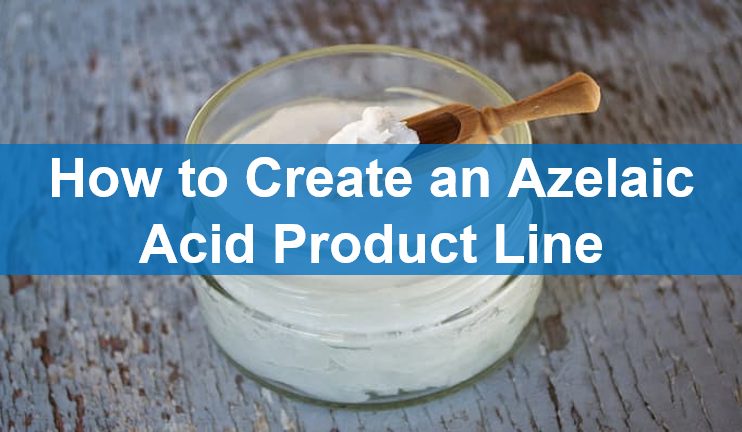
- HOME
- Cosmetic OEM Lab
I want to develop an azelaic acid product line.
What exactly are the benefits of azelaic acid?
As consumers become more ingredient-savvy, skincare brands must rise to the challenge of creating solutions that are both effective and gentle. One powerhouse ingredient that has been gaining attention for its multitasking abilities is azelaic acid—a dermatologically respected compound known for its anti-acne, anti-inflammatory, and brightening properties.
Particularly ideal for sensitive and acne-prone skin, azelaic acid is quickly becoming a must-have in modern skincare formulations. If you’re looking to develop a targeted product line that speaks to the growing demand for gentle yet results-driven treatments, azelaic acid may be the hero ingredient your brand needs.
In this comprehensive guide, we’ll explore what makes azelaic acid a standout choice, the growing market opportunity it presents, and how to strategically launch your own azelaic acid product line from formulation to regulatory compliance and branding.

Contents

Azelaic acid has been widely recommended by dermatologists for decades, yet it’s only recently gained popularity in mainstream beauty and skincare circles. Let’s explore what makes it so special.
Azelaic acid is a naturally occurring dicarboxylic acid derived from grains like barley, wheat, and rye. In skincare, it is used as a topical treatment to address a variety of skin concerns, especially rosacea, acne, and hyperpigmentation.
Available in both over-the-counter and prescription-strength formulas, azelaic acid works by:
Azelaic acid offers multi-functional benefits, making it a highly versatile ingredient in both medical and cosmetic skincare:
This powerful yet non-irritating acid stands out in the AHA/BHA category for being well tolerated and non-photosensitizing, making it suitable for daily use and all seasons.
Azelaic acid is particularly suited for:
Its mild yet effective nature makes it ideal for inclusion in entry-level exfoliating products or as part of a comprehensive acne and pigmentation treatment routine.

Azelaic acid isn’t just effective—it’s increasingly in demand. As clean beauty and clinical-grade formulations converge, this ingredient is uniquely positioned to thrive in multiple skincare categories.
Compared to popular acid ingredients like glycolic, salicylic, and lactic acid, azelaic acid offers a superior balance between efficacy and tolerability:
| Ingredient | Main Benefit | Irritation Potential | Photosensitivity |
| Glycolic Acid | Exfoliation | Medium to High | Yes |
| Salicylic Acid | Oil control, acne | Medium | Mild |
| Azelaic Acid | Acne, rosacea, pigmentation | Low | No |
| Lactic Acid | Hydration & exfoliation | Mild to Medium | Yes |
This makes azelaic acid a safer alternative for consumers who want visible results without the common side effects of harsher exfoliants.
When developing an azelaic acid product line, it’s crucial to understand regional regulatory frameworks:
| United States |
|
| European Union |
|
| Asia |
|
Make sure to consult with legal and regulatory professionals when planning international distribution.
Azelaic acid can be used in a range of product formats, including:
Combining azelaic acid with supporting ingredients like niacinamide, ceramides, or green tea extract enhances its efficacy and provides a complete skincare experience.

Creating a successful skincare line requires more than just a star ingredient. Here’s how to build a science-backed, consumer-friendly azelaic acid range that aligns with your brand vision.
While 10% azelaic acid is commonly used in OTC(Over-The-Counter) formulations, lower concentrations (around 5%) may be better for sensitive skin introductions. Consider complementing it with:
Ensure your formulation maintains a skin-friendly pH (~4.5–5.5) to optimize absorption and minimize irritation.
Whether you’re targeting the U.S., EU, or Asia, your products must go through:
Don’t skip the Product Information File (PIF) or Cosmetic Product Safety Report (CPSR) required for EU compliance.
Launching an azelaic acid product line becomes much easier with a trusted OEM (Original Equipment Manufacturer) partner who understands:
Look for OEMs with a proven track record in dermatologically tested or cosmeceutical formulations, and who offer low MOQs(Minimum Order Quantity) for startups.

Azelaic acid is no longer a hidden gem—it’s a rising star in modern skincare known for treating acne, calming sensitive skin, and delivering clear, even-toned results without harsh side effects. For brands looking to build a science-backed, dermatologist-approved product line, this multi-functional acid offers unmatched potential.
With proper formulation, compliance, and branding strategy, launching an azelaic acid skincare line can help your company meet the growing demand for gentle, effective skincare solutions tailored for sensitive and acne-prone skin.
Ready to bring your vision to life? A smart, sustainable azelaic acid product line could be your next big success in the evolving beauty industry.
Inquiry
For further information, please contact us.